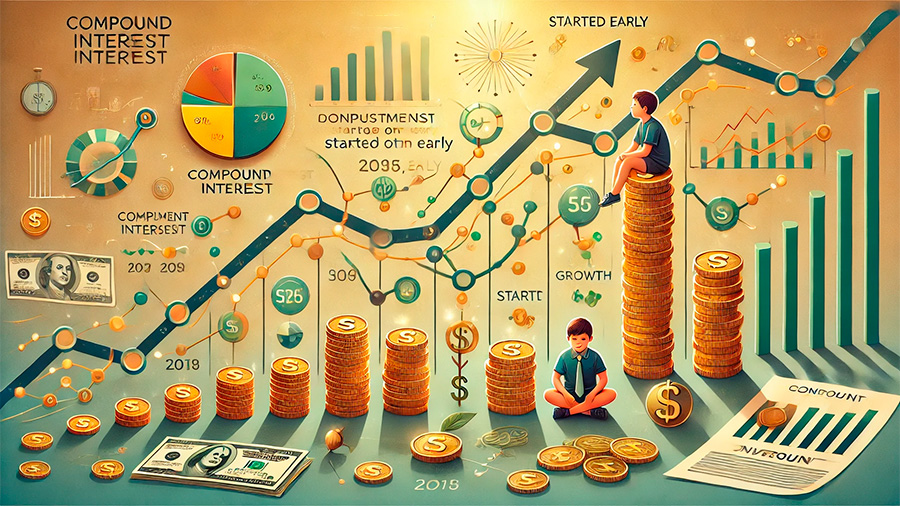Compound interest is often described as one of the most powerful forces in finance, and for good reason. By reinvesting your earnings and allowing your money to grow over time, compound interest can significantly increase the value of your investments. It’s a fundamental concept that every investor should understand, as it can help you maximize your returns, build wealth, and achieve your long-term financial goals.
In this article, we’ll explore how compound interest works, why it’s so powerful, and how you can leverage it to make your investments work for you. Whether you’re just starting out or have been investing for years, understanding the mechanics of compound interest can change the way you approach saving and investing for the future.
What Is Compound Interest?
Compound interest is the process of earning interest on both your initial investment (the principal) and the accumulated interest from previous periods. Unlike simple interest, where you only earn interest on the principal, compound interest allows your money to grow exponentially over time as you continue to earn interest on an ever-increasing amount.
1. How Compound Interest Works
When you invest money in an account that earns compound interest, you’re essentially allowing your investment to grow at an accelerating rate. Each time interest is added to your account, that interest becomes part of your principal, which means future interest calculations are based on a larger sum.
- Compounding periods: Interest can be compounded at different intervals, such as annually, quarterly, monthly, or even daily. The more frequently interest is compounded, the faster your investment will grow. For example, if interest is compounded quarterly, you’ll earn interest four times a year, with each interest payment added to your principal for the next calculation.
- Exponential growth: Because interest is calculated on an ever-growing balance, compound interest creates exponential growth. This means that the longer you keep your money invested, the more it accelerates in value over time.
For example, if you invest $1,000 at an annual interest rate of 5%, compounded yearly, your investment will grow to $1,628 after 10 years. However, after 20 years, it will grow to $2,653—not just doubling your money, but more than doubling it because of the power of compounding.
2. The Rule of 72
A useful shortcut for understanding how quickly your investment will grow with compound interest is the Rule of 72. This rule estimates the number of years it will take for your investment to double, based on the annual interest rate.
- The calculation: To use the Rule of 72, simply divide 72 by your investment’s annual interest rate. For example, if you’re earning a 6% return, your investment will double in approximately 12 years (72 ÷ 6 = 12).
The Rule of 72 highlights the importance of earning higher interest rates and reinvesting your returns to maximize growth over time.

Why Compound Interest Is So Powerful
The power of compound interest lies in its ability to accelerate the growth of your investments over time. This is especially true when you start investing early and allow compounding to work its magic for decades.
1. Time Is Your Biggest Asset
One of the most important factors in harnessing the power of compound interest is time. The longer you leave your money invested, the more time it has to grow, and the greater the impact of compounding.
- Early investing advantage: If you start investing early, even small contributions can grow significantly over time. For example, someone who starts investing at age 25 with modest contributions will have much more money by retirement than someone who starts at 35, even if the latter contributes more money overall.
- Exponential growth over time: As your investment continues to earn interest on both the original principal and the accumulated interest, its value grows exponentially. This means that the greatest growth happens in the later years of your investment, after compounding has had time to build momentum.
By investing early and allowing compound interest to work for decades, you can achieve much higher returns than if you start investing later in life.
2. Small Contributions Add Up
You don’t need to invest large sums of money to benefit from compound interest. Even small, regular contributions can grow into substantial amounts over time. The key is consistency—making regular contributions and reinvesting your earnings to keep the compounding process going.
- Dollar-cost averaging: By investing a fixed amount regularly, such as monthly or quarterly, you take advantage of dollar-cost averaging. This strategy helps reduce the impact of market volatility by spreading out your investments over time. As your contributions grow and earn compound interest, your investment balance increases steadily.
- Reinvesting dividends: If you’re investing in stocks or mutual funds that pay dividends, reinvesting those dividends can significantly boost the compounding effect. Rather than taking the dividends as cash, reinvest them to buy more shares, which will generate additional returns over time.
Regular contributions, no matter how small, combined with reinvested earnings, can dramatically increase your investment’s value thanks to compound interest.

How to Maximize Compound Interest in Your Investments
To make the most of compound interest, it’s important to implement strategies that optimize your investment returns and minimize unnecessary losses. Here are some practical tips for maximizing compound interest in your portfolio.
1. Start Investing Early
As mentioned earlier, time is the most important factor when it comes to compound interest. The sooner you start investing, the more time your money has to grow. Even if you can only invest small amounts at first, starting early can make a big difference over the long term.
- Don’t wait for large sums: Many people delay investing because they feel they don’t have enough money to make a difference. However, even small contributions can grow substantially over time with the power of compounding. Start with what you can, and increase your contributions as your income grows.
- The earlier you begin: The earlier you begin, the more time compound interest has to work, allowing you to build significant wealth with relatively modest contributions.
2. Choose Investments with Higher Returns
The rate of return on your investments plays a crucial role in how quickly compound interest can grow your wealth. While bonds and savings accounts offer lower, safer returns, investing in higher-yielding assets like stocks or mutual funds can accelerate the compounding process.
- Balance risk and reward: Higher returns often come with higher risk, so it’s important to strike a balance based on your risk tolerance and financial goals. For long-term investors, stocks and equity mutual funds typically offer higher returns compared to fixed-income securities.
- Growth-oriented investments: Focus on growth-oriented investments, such as index funds or growth stocks, that have the potential to deliver higher returns over the long run. These types of investments can take full advantage of compound interest, especially over extended periods.
Higher returns, combined with the power of compounding, can lead to exponential growth in your investment portfolio.
3. Reinvest Your Earnings
To maximize the benefits of compound interest, it’s essential to reinvest any earnings you receive from your investments. Whether it’s interest, dividends, or capital gains, reinvesting allows you to keep growing your principal and enhancing the compounding effect.
- Dividend reinvestment plans (DRIPs): Many companies and funds offer dividend reinvestment plans, which automatically reinvest your dividends into additional shares of the stock or fund. This can significantly boost your returns over time by allowing you to compound both the value of your original investment and the additional shares you acquire.
- Avoid withdrawing early: While it may be tempting to withdraw your earnings, doing so can slow down the compounding process. Instead, let your investments continue growing to take full advantage of compound interest.
By reinvesting your earnings, you can accelerate the growth of your portfolio and build wealth more quickly.
4. Minimize Fees and Expenses
Investment fees and expenses can eat into your returns and reduce the effectiveness of compound interest. Even seemingly small fees can have a significant impact on your long-term wealth, as they compound over time just like your investment returns.
- Choose low-cost investment options: When selecting investments, pay attention to management fees, expense ratios, and other costs. Low-cost index funds and ETFs are often good choices for long-term investors because they offer broad market exposure at a fraction of the cost of actively managed funds.
- Avoid frequent trading: Frequent trading can lead to higher transaction costs and reduce your overall returns. Instead, focus on a buy-and-hold strategy that allows your investments to grow over time with minimal interference.
By minimizing fees and expenses, you can keep more of your returns and let compound interest work its full magic.
The Impact of Compound Interest on Different Investment Accounts
The type of investment account you use can also affect how much compound interest benefits your portfolio. Tax-advantaged accounts like IRAs and 401(k)s are particularly powerful when it comes to compounding because they allow your investments to grow tax-free or tax-deferred.
1. Tax-Deferred Accounts (Traditional IRAs, 401(k)s)
In tax-deferred accounts like Traditional IRAs and 401(k)s, you don’t pay taxes on your investment earnings until you withdraw the money in retirement. This allows your investments to compound more efficiently because the full amount of your earnings stays invested and continues to grow.
- Maximize contributions: Take advantage of the annual contribution limits for tax-deferred accounts to maximize your savings. The more you contribute, the more you benefit from compound interest over time.
- Employer matching: If you have access to a 401(k) with employer matching, be sure to contribute enough to take full advantage of the match. This is essentially free money that will further enhance the compounding effect.
Tax-deferred accounts allow your investments to grow without the drag of annual taxes, making them an excellent choice for long-term compounding.
2. Tax-Free Accounts (Roth IRAs)
In a Roth IRA, your investments grow tax-free, and you won’t pay taxes on qualified withdrawals in retirement. This is another powerful way to harness the benefits of compound interest, as you get to keep all of your investment gains without paying taxes on them.
- Start early with a Roth IRA: Since Roth IRAs allow for tax-free growth, starting early and contributing consistently can lead to substantial wealth accumulation over time.
- Tax-free withdrawals: When you retire, you won’t owe any taxes on your Roth IRA withdrawals, which means you get to keep more of your compounded earnings.
Roth IRAs are especially beneficial for younger investors who have time on their side and expect to be in a higher tax bracket in the future.
Final Thoughts: Harnessing the Power of Compound Interest
Compound interest is one of the most powerful tools available to investors, allowing your money to grow exponentially over time. By starting early, choosing investments with higher returns, reinvesting your earnings, and minimizing fees, you can maximize the impact of compound interest on your portfolio.
Whether you’re saving for retirement, building wealth, or achieving other financial goals, understanding and leveraging compound interest can make a significant difference in your long-term success. The sooner you start, the more time your money has to grow, giving you the best chance to benefit from this powerful financial force.



